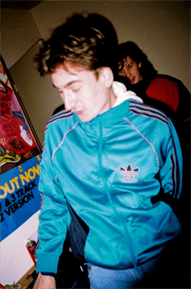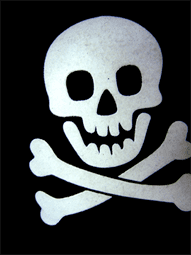Confessions of a Pirate Radio DJ
Wednesday, October 18, 2017
by Tat
BBC Four recently broadcast a documentary hosted by London rapper Rodney P on the generation of pirate radio stations and DJs that operated in London in the 1980s. The film captured what it was like to be a pirate DJ on the dance music stations that risked everything to get their sounds heard by tens of thousands of enthusiastic black music fans. This was a new generation of DJs who were very unlike the first generation of pirates who broadcasted from ships such as Radio Caroline. The new generation climbed on the tops of tower blocks to host their aerials and play music that was not being heard on the BBC or commercial stations except for the likes of John Peel on Radio One and Mike Allen on Capital Radio. At the end of the 1980s a few stations finally gained legal status and were to change broadcast radio forever. At the same time the next generation of radio stations started life thanks to a huge interest in underground music driven by the acid house and rave scenes. In 1990 I started my first residency on a Sheffield pirate radio station, Hardcore FM.
Hardcore you know the score
I'm not entirely sure how I ended up on pirate radio, I can't recall whether I approached them or whether it was the other way round. Let's not forget this was before the advent of social media and everyone having a mobile phone, how we actually organised things is a little beyond me. I was DJing at a club in my home town and left the venue to be greeted by a guy outside who asked whether I would like to be a DJ on a new pirate radio station in Sheffield called Hardcore FM. I'd been DJing for about 2 years before, but had long been obsessed by the radio since being a young teenager. I'd grown up listening to Radio Luxembourg and John Peel on Radio One, whilst I had spent much of my late teenage years making my own radio shows on tape called Tat on 2. So fast forward to 1990 and I was offered my own radio show in a dodgy Sheffield tower block. For a 23-year-old naive lad from a small town that was more than 99% white and heavily working class, it seemed quite a culture shock. I was handed a scrap of paper with an address in Sheffield, it was the location of the station.
I joined Hardcore FM in partnership with an old friend and DJ under the name of Inspiration. So in 1990 Tat and Inspiration took to the airwaves once a week between 8-10pm playing the latest house, techno, rave and piano tracks. The first thing that caught my attention was the network of people involved in the station. From those in the background running things such as the broadcasting equipment, to sorting advertising out, to the DJs and general admin answering the phones and taking shoutouts. It was my first experience of mobile phones as we operated a phone-in system for shout outs using car phones that were the size of a breeze block.

Transfer Market
Hardcore FM grew in popularity but in the background something else was going on as a rival station was setting up and with that an intention to lure away all of Hardcore FM's talent. I was approached by a couple of guys who had pseudonyms that made them sound like 1970s reggae artists. I was told about a new station that was going to take things to the next level and with that I had jumped ship. Along with me came the local talents of Asterix and Space, Easy D, DJ Dream among others to the new station. It was a time of great excitement and high anxiety. On one hand we had a new and well organised station and some fresh DJs joining the best Sheffield DJs at the time. On the other hand there was an underlying nervousness as rumours were going around that the ex Hardcore Fm DJs who were regarded as traitors by the old station would not get away with their transfer so lightly. I recall leaving clubs and raves after DJing and Fantasy FM studio late at night wondering whether I would meet the Hardcore FM management and get a bit of a hiding. In the end nothing came of it and Fantasy FM grew to be a leading station in the North very quickly. It could be heard as far and wide as Hull and Leeds and had thousands of followers. The station was so popular that it hosted a launch party at The Sheffield City Hall Ballroom which sold out in very little time. From about 1991 for the next couple of years Fantasy FM ruled South Yorkshire's airwaves whilst other rival stations also started to appear.
Whilst the station ran there was the many club and illegal rave nights that the station promoted. It soon became apparent to the DJs that stations needed money to pay for rent, equipment, security, electricity and our phone. The nights helped fund the whole process so it became paramount to run the adverts that promoted nights with 10k sound systems, flavoured smoke and the best DJs in town. If you forgot to play a set of adverts the studio phone would ring as one of the management - who seemed to be tuned in 24-7 - would deliver a stern reminder to play the advert tapes. On the walls were simple notes to advertise the telephone number, various club nights and to play the adverts on time.
The studio
The studios, for want of a better word, were sparse, often located in the living room of the flat and usually at least 8 floors up. If you were lucky you had a balcony where you could go outside to see the city lights sprawling out in front of you. Back inside there was usually a settee and a couple chairs, and a long table with the decks, mixer and microphone on. The phone was a large mobile unit that you only ever saw in 1980s businessmen's cars and that would often sit by one of the chairs whilst a member of our crew would take the calls. The Tat and Inspiration show was very popular and we would regularly get about 100 calls in just two hours of broadcasting. We would send shout outs to the Arbourthorne Crew, people in the Big Red Bus and anyone else looking for a mention. After a year on Fantasy FM I decided to go it alone as I realised that my musical path had become very different to that of Inspiration's. I started my own Tuesday Night show and realising that I needed more joined Fantasy's sister station Sheffield Community Radio (SCR). SCR had a huge reputation and had been long established within Sheffield's Afro Caribbean Community. There were a few house shows, but it was mostly lovers rock, reggae and soul, I would bring all kinds of stuff from techno, hip hop, rave and house on a Saturday Night.
The environment
The flats were an insight into how many people in inner cities lived and for a boy from a working class housing estate, I realised then how lucky I was. Dirty nappies in the lifts, drug dealers, prostitutes and other things I'd only associated in the lyrics of Grandmaster Flash and The Furious Five's 'The Message' were suddenly much closer to home. A steel plate on the station's flat was an indication that the police could arrive any time, or possibly a rival station wanting to steal your equipment. On occasion were were taken down by the police and after a few days, possibly weeks we would be back up again, in a new location with new equipment. In the six years I spent on Hardcore, Fantasy, SCR and Dance FM, I must have broadcast from a dozen different flats. The worst of which was one that clearly had been recently vacated by a goth as the walls in each room were painted the darkest black paint imaginable. Just a few hours in the studio left you feeling like the life had been sucked from you. Whilst each and every bathroom we had was not much better than those at a 1990s Glastonbury festival on the last day. They were dirty, smelly and places you did not want to spend any longer in than you needed. Occasionally the flat would have their own landlord or landlady as we had obviously sublet from them and we would find ourselves delivering a show whilst they were either hosting a party in the next room or passed out on the couch in the studio. It was clear that they had been instructed not to interfere with the radio. It all added to the ambience of the place.
Game of cat and mouse
Occasionally we would get calls from rival stations saying that they had just been visited by the police and that they were coming for us next. You could never take a chance with things like this, so any call would leave us locking up and leaving as soon as we could. Even worse was that these were the kind of areas that the police visited on a regular basis so seeing a police car parked outside as you left with your bag of records could be a nerve wracking affair. The law had changed come turn of the decade so not only did stations run the risk of being taken off air but if caught, we ran the risk of losing all of our equipment and records plus a court appearance. Every DJ I met around that time was doing this for the same reason, and that was to share new, underground records with the thousands of listeners who were tired of hearing the same old formulaic music played on national and commercial radio stations. One defence that developed to support the stations was the microwave links between transmitters meaning we no longer needed to be in the same tower block as our transmitter. This was good news as our aerial could be taken down, but it meant our station remained intact. This happened on a few occasions as we would lose the transmission signal in the studio once the aerial was taken down. We would use a radio to broadcast into the studio so we could hear that we were transmitting fine, if the sound went off the radio we knew that we had been attacked. Often this resulted in shutting the station down and then opening again a few days later with a new location. It was the ultimate game of cat and mouse.
The legacy
It was an incredibly exciting, if not edgy time, friendships were formed and DJ careers built. Pirate radio changed how commercial radio was run, we had brought in the community via the shout outs and club nights, commercial radio had never been interested in the listener and now shout outs are a regular feature thanks to social media and text messaging. Vibrant, edgy and underground music was now making its way onto national radio as they realised there was a groundswell of support for something new. The pirates of the 1980s made that happen, those that followed ensured the message was drilled home. By the time I left pirate radio in 1996 the scene had moved on to large legal clubs and the illegal rave scene was just a fraction of what it once was. Dance music was now on the nation's airwaves and the Glastonbury main stage and there was not the demand for pirate radio stations like there were once was. Many of the pirate DJs had now gone legal and were establishing themselves on stations based in London, Manchester and Birmingham. Many of Sheffield's original pirates had also moved on, either they had given up DJing for a day time career, family or other reasons. Those that continued delivered their music strictly back in the clubs and there are still a few Fantasy FM DJs still playing regularly in clubs, with such as Solid State, Chris Duckenfield, Martin Leverton and Danny Wootton still incredibly active two decades after Fantasy's demise. Fantasy FM has gone down in Sheffield dance music folklore, as have SCR within the community as both maintained a high standard of activity. It was illegal and everyone knew it, but the benefits outweighed the risks for all concerned. It helped underpin Sheffield's dance music community, it was a place where people could hear new underground music without venturing out of their house, something that was unheard of before then. The internet now has thousand of internet radio stations and tens of thousands of DJs. The do it yourself nature of pirate made all what followed very possible and for those involved, an incredibly enjoyable experience.
Discover digital dance music with Trackhunter







